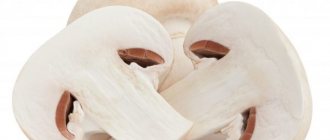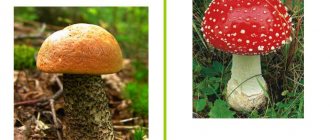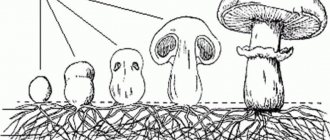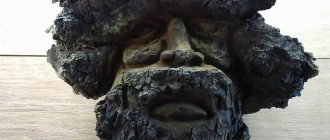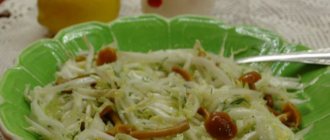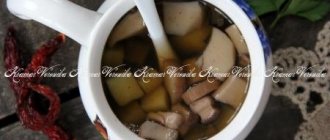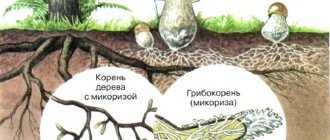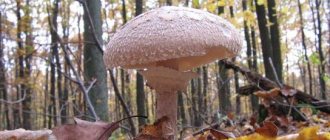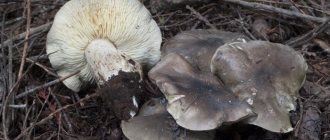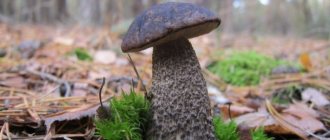General characteristics of mushrooms
Mushrooms are a special group of nuclear organisms of living nature
They appeared on our planet a very long time ago. Their remains were found in ancient geological layers. More than 100 thousand species of mushrooms are known.
Mushrooms are widespread in all zones of the globe: in soil, water, living organisms and dead remains, on tree trunks. Fungi are also found on the surface of metals, rubber products, products, and buildings.
Mushrooms are very diverse in size: from the smallest, visible only under an iodine microscope, to large ones, weighing several kilograms (Fig. 1). Fungi have characteristics characteristic of both plants and animals.
Fig.1 Mushrooms. Unicellular (yeast), capped (white), parasitic (tinder fungus).
Signs of plants characteristic of mushrooms:
like plants, they are motionless, growing all the time while they are viable; branch out; the cell is covered with a thick membrane; They feed without swallowing, like animals, but by absorbing nutrients throughout the entire surface of the body.
Animal characteristics characteristic of mushrooms:
They do not have chloroplasts, so they do not undergo photosynthesis. They feed, like animals, on ready-made organic substances, since they are not able to form them in their cells; the cell wall, like that of insects, is protein-chitin; The cell's storage nutrients are different from those of plants. In plants, the nutrients are starch, and in fungi, like in animals, the reserve substance is glycogen.
Based on these specific characteristics, mushrooms belong to an independent group of living nature. They form a separate - third - kingdom of living organisms.
The science that studies mushrooms is called mycology (from the Greek mykos - mushroom).
Difference between fungal cells and plant cells
The most important difference between mushrooms and plants is the fact that they are able to live in places where there is practically no oxygen. They are also distinguished by their way of eating. Due to the lack of chlorophyll, mushrooms are not capable of photosynthesis. Therefore, nutrition can only occur in a heterotrophic manner. Mushrooms feed by breaking down glucose, and plants get energy from carbon dioxide.
Metabolism in mushrooms occurs thanks to lecithin and glycogen, while in plants they are simply absent.
The poison, which is contained in some types of mushrooms, is very similar in chemical composition to snake venom, but has nothing in common with plant poisons. Thus, fungi have more characteristics in common with animals than with plants.
Fungal cell structure. Features of life.
The body of mushrooms is mycelium, which consists of intertwined thin threads called hyphae (from the Greek hyphae - fabric, web). Typically, the hyphae grow at their tips, branch and grow strongly, forming a mycelium.
In lower fungi with a primitive structure, for example in mucor, the hyphae do not have partitions, and the entire body of the fungus is one giant branched cell.
In most fungi, the hyphae are divided by septa into individual cells, which are arranged in a chain one after another. With the help of hyphae, fungi absorb organic and inorganic substances.
Depending on the type of mushroom, their hyphae, entwined around some object, are visible from the outside (white mold, mucor, penicillium, aspergillus). Since the hyphae of higher mushrooms, such as cap mushrooms, penetrate deep into the soil, they are not visible from the outside. Fungi entwining trees are also not visible, since their hyphae penetrate inside the cells.
The cells of the fungus are covered on the outside with a dense membrane. They have cytoplasm, nucleus, mitochondria, lysosomes, ribosomes and vacuole. Glycogen, fats and fatty acids are deposited in the vacuole (Fig. 2).
Fig.2 Structure of a mushroom cell.
Under unfavorable environmental conditions, these substances contribute to the body's stability.
Lichens: their diversity, structural features and life activity
Mushrooms are divided according to structural features, spore formation or sexual reproduction into the following sections.
The structure of lichens
Rice. 5. Pioneer lichens on rocks
Of particular interest from this group of organisms are lichens ( Fig. 5 ). It is a symbiotic group of organisms that includes fungi (microbionts) and microscopic green algae or cyanobacteria (photobionts). Sometimes a triple tandem is formed: a fungus, a bacterium (cyanobacterium) and an algae. The microbiont builds a thallus or thallus, inside which the photobiont cells “hide”. The relationship is in contact: the fungus grows in parallel with the algae cells.
Between the algae and the fungus there is a layer formed by an intercellular substance, which serves as a “bridge” for metabolic processes. Most often, algae cells are evenly distributed throughout the thallus; sometimes they are “hidden” in separate crusts of mycelium. Fungi use hyphae to penetrate algae cells if they lack organic matter.
Note: Lichens are unpretentious living organisms that can withstand different climatic conditions. They are able to dry out and, under favorable conditions, fill tissues with water and resume vital processes.
Lichens form a huge community, which numbers 26,000 species, and inhabit all geographical zones and areas, including those unsuitable for habitation. Withstands temperatures ranging from -50 to +87C. They grow on the roots and trunks of trees, on stones, on the surface of the soil, in the water column.
They reproduce vegetatively by dividing the thallus. Thanks to small pieces of thallus poorly attached to the main “body”, they are algae cells entwined with fungal hyphae. They easily come off and are carried by the wind to a new place. Lichens are also characterized by asexual and sexual reproduction.
Features of relationships
The fungus feeds as a heterotroph, while the algae is an autotrophic organism. This allows two groups of organisms to cooperate mutually: the fungus supplies the algae with water and nutrients, and the algae synthesizes organic substances for the fungus.
Lichens grow slowly, gradually gaining mass, and their lifespan is hundreds and thousands of years. These are one of the longest-livers on planet Earth.
Variety of shapes
Slan (thallus, thallus), unlike plants, does not have a root, stem, or leaves; it is integral in its structure. Lichens are distinguished by an enviable diversity, which is reflected in the table.
| Type | Slan structure | Examples |
| Scale: live on the most unfavorable surfaces for life | Slan 1-5 mm thick looks like a crust, thoroughly fused with the substrate | Lecidea, xanthoria, aspicillia, lecanora, biatora |
| Leafy: grow on tree bark, stumps, rocky ledges | The slan is round in shape with dissected, uneven edges with a diameter of 10-20 cm. They form a lower flat layer and leaf-like outgrowths. | Parmelia, lobaria, peltigera, nephroma, gyrophora |
| Bushy: creep along the ground or hang from tree branches ( Fig. 6 ) | The slan resembles a stem-like shape and is attached with the lower part to the substrate. The branched upper part is raised up or hangs down. They look like hollow, round tubes. | Moss moss, usnea, citraria, evernia, ramalina |
Rice. 6. One of the varieties of fruticose lichen
This is interesting: Lichens include 20% of the fungi of the entire mushroom kingdom. The species diversity of algae participating in the symbiosis is quite small. Half of the lichens contain a single algae, Trebuxia. Cohabitation occurs as a result of a chance meeting of species, so some forms of lichens are created in the laboratory.
Mushroom propagation
Different fungi reproduce in different ways: vegetatively, asexually and sexually. The easiest way is vegetative, when the fungus propagates by pieces of mycelium. If a small part of the mycelium finds itself in favorable conditions, it grows and gives rise to a new mushroom.
Asexual reproduction. Fungi mainly reproduce using special tiny cells called spores (Fig. 3). Spores are formed in sporangia. The wind carries spores over long distances. Once in favorable conditions, the spore germinates and a new mycelium develops from it.
Fig.3 Sporangium with mold spores.
Motile flagellated spores of protozoan fungi are called zoospores. Most of them are aquatic inhabitants: with the help of flagella, cells can only move in an aquatic environment.
Conidia is a type of spore (from the Greek koniya - dust, eidos - species). They are formed directly on the mycelium or special outgrowths (Fig. 4).
Fig.4 Conidiophore and chain of conidia.
During sexual reproduction, two cells from different myceliums join together, and the nuclei of these cells merge into one nucleus. After some time, the zygote divides and new cells turn into spores. The mushroom grown from the spore will combine the characteristics of both parent mushrooms.
Lamellar mushrooms
Russulas, milk mushrooms, mushrooms, mushrooms, champignons
They have caps that look like a small accordion from thin plates from below. These are lamellar mushrooms.
When determining them, an important role is played by the frequency of the plates per square centimeter, width, thickness and color.
No less significant are the methods and forms of attachment to the leg (in the center, side, edge).
Unicellular fungi
Using sugar (yeast) fungi as an example, let’s look at unicellular fungi. The structure of a yeast fungus is very simple: a single-celled organism does not have a mycelium. Spherical or oval cells have a membrane, cytoplasm, nucleus and vacuole. Being unicellular forms, they, like multicellular ones, breathe, feed, grow, reproduce, and metabolism occurs in them. Unlike other fungi, they can exist for a long time in an oxygen-free environment.
The yeast fungus reproduces very quickly by vegetative means - by budding (Fig. 5). In this case, a process appears on the mother cell, which gradually increases in volume. Having reached the size of the mother cell, it now produces the next process.
Fig.5 Vegetative propagation of yeast fungus (budding).
And then in the form of a chain, without separating from each other, they will grow. Sometimes a cell reproduces by division. During sexual reproduction, two vegetative cells unite. Due to lack of nutrients, a bag of spores is formed. The zygote of the yeast fungus turns into a bag.
If the nutrient medium contains a high sugar content, then the cells, processing sugar into alcohol and carbon dioxide, begin to actively multiply, causing fermentation. These mushrooms are widely used in the production of wine, beer, koumiss, milk, and in the baking industry.
When making beer, barley is mixed with hop inflorescences, yeast is added, and left to ferment. Therefore, beer contains up to 6% alcohol, sugar, protein, organic acids, tannins and carbon dioxide.
Yeast used for silage contains proteins, carbohydrates, fats and mineral salts. Yeast is perfectly absorbed by the human body; when consuming yeast, it is diluted with water. When used in the baking and confectionery industry, yeast is used that is well-dissolved and diluted with hot boiled water.
Yeast breaks down sugar, producing alcohol and carbon dioxide. Carbon dioxide forms bubbles in the dough and fermentation occurs. In nature, yeast fungi can be found on sweet berries and fruits, in flower nectar, tree sap, and bee honey.
Yeast cells contain sufficient quantities of proteins, fats and vitamins. Therefore, they are used in the manufacture of medicines for boils, styes, and acne. Fungi are called yeast because of their ability to cause fermentation. Saccharomycetes are of greatest importance to humans.
Using mushrooms for nutrition and medicine
Mushrooms are a source of numerous medicinal drugs. They are especially popular in Eastern countries: China and Vietnam. Each mushroom is unique and contains a set of components that are used for the benefit of humans:
- Oyster mushroom contains digestible protein for diabetics;
- Chanterelle is rich in substances that clear the intestines of helminths and toxins;
- camelina contains antibacterial components;
- combed hedgehog strengthens immune defenses and enhances the growth of nerve cells (is on the verge of extinction);
- birch polypore is used as an antiseptic, infusions help fight ulcers and cleanse the gastrointestinal tract;
- chaga (tinder fungus) has anti-cancer effects;
- meadow champignons synthesize a potent antibiotic.
This is not a complete list of examples when decoctions, infusions, extracts are prepared from mushrooms, and medicines are synthesized.
Note: Many pharmacological studies on mushrooms were conducted in the 70s and 80s. The resulting compounds are tested on animals and the work is still far from complete completion. Thus, at your own risk, you use red fly agaric in folk medicine ( Fig. 4 ), the therapeutic effect of which is not recognized by official medicine.
Rice. 4. Poisonous fly agaric is widely used in folk medicine
In nutrition, proteins, citric acid, and enzymes are obtained from representatives of the mushroom kingdom. They are widely used in the baking industry, winemaking, and cheese making.
Molds
Molds, like yeasts (Saccharomycetes), are one of the common microscopic fungi. They are often found in everyday life. Consider the so-called white mold, or mucor fungus (simply mucor). In nature, mucors are widely distributed on last year's leaves; in grass, manure.
A layer of mold resembling cotton wool appears on the surface of flour products and bread left covered for 2-3 days. These are hyphae of the mucor fungus, which are actually one single cell. Mukor belongs to the lower mushrooms. The mucor hyphae intertwine to form a mycelium. Mucor lacks chlorophyll, so organic matter cannot be formed.
Mucor feeds by absorbing ready-made organic substances from the external environment. The hyphae of the fungus therefore grow upward. At the ends of the hyphae there are sporangia (bags) similar to black dots. Each bag is filled with many spores. The spore consists of one cell, covered on the outside with a thick membrane (Fig. 6).
Fig.6 Mukor.
The cell contains cytoplasm and nucleus. Once in favorable conditions, the spores begin to germinate, forming hyphae. Under unfavorable conditions, they reproduce sexually - two cells merge.
Molds also include penicillium and aspergillus. They feed on ready-made organic matter. Like other fungi, they are involved in the spoilage and rotting of fallen fruits and seeds of plants, as well as various products. Penicillium colonies are bluish, while Aspergillus colonies are yellowish-green (Figure 7).
Fig.7 Penicillium and aspergillus.
Under a microscope, colorless hyphae are clearly visible, separated by septa. The spore-forming special hyphae of penicillium are multicellular, finger-like branched. Aspergillus spores develop from cells located at the expanded ends of spore-forming unicellular hyphae.
Two types of penicillium are used in medicine to produce penicillin. This medicine is used in the treatment of pneumonia, rheumatism, diphtheria, scarlet fever and other diseases. Penicillin quickly cures many inflammatory diseases.
Citric acid is obtained from one species of aspergillus. By their properties, some types of penicillium and aspergillus help maintain balance in nature, since they limit the growth of particularly harmful organisms.
Along with this, mold fungi also cause harm. They cause rotting of potatoes, fruits, and grain crops. For preventive purposes, warehouses must be dried and treated with chemicals before storing various fruits, berries, grains, potatoes, and carrots. In addition, it is necessary to maintain optimal temperature in warehouses.
The structure of a mushroom cell
The cell structure of these organisms also has its own characteristics. It is simpler than that of representatives of other kingdoms. Fungi have a cellular structure closer to that of plants. But they store glycogen rather than starch as an energy source. In addition, they cannot synthesize organic substances.
The fungal cell is covered with a hard shell, which consists of chitin, proteins, fats and carbohydrates. Behind the shell is a membrane, inside of which there is cytoplasm. As in animals, the cells lack plastids, but have a cell center and several vacuoles.
One of the features of fungal cells is that they can contain several nuclei. This is explained by the fact that they do not have a connection between cytokinesis and nuclear division. That is, when the nucleus divides, a new cell is not always formed. These organisms are also characterized by the presence of dikaryons. These are special germ cells in which female and male nuclei are present. Chromosomes are very small, there can be from 2 to 28.
Shell
The membrane is what distinguishes the cell structure of these organisms from representatives of other kingdoms. With its help, contact with the environment occurs. It may have different composition and functions depending on the phase and type of growth of the fungus. In older organisms, a layer of mucus or calcium oxalate may form on its surface.
The main component of the shell is chitin, sometimes it takes up more than half of its weight. Some species contain chitosan, cellulose, galactose, and mannose. Often the shell is multilayered, which increases its resistance to destruction and determines the shape of the vegetative bodies.
Cytoplasm
Separated from the shell by a membrane consisting of lipids and proteins. Its function is to regulate the flow of nutrients inside. The cytoplasm includes organelles as well as microtubules that make up the cell skeleton.
Mitochondria are similar to plant ones, and Goji bodies are almost absent. In addition, the fungal cell in this part has another feature. Near the membrane there are special bodies - losomesomes, which have not yet been fully studied.
Core
The nucleus in a mushroom cell is small, with a double membrane. It may lack a nucleolus. Some cells may contain several nuclei. The main function of this part of the cell is DNA replication.
The peculiarity of these organisms is that they may have paired nuclei. Their mitosis is closed, the nuclear membrane is not destroyed after division. In this case, a new cell is not always formed, so it ends up with several nuclei.
During the process of life activity in the fungal cell, plant starch is not produced. But it contains a lot of glycogen, which acts as an energy reserve. Another feature is that the nuclei can move from one fungal cell to another.
Vacuoles
Vacuoles are places where reserve nutrients accumulate. In young organisms they are small, and with age they merge into one large vacuole. Nutrients are not always stored in vacuoles. They can be located directly in the cytoplasm in the form of drops or granules.
Inclusions
Various inclusions are located inside the cytoplasm. They can be harmful or beneficial. These inclusions are involved in reproduction, provide nutrients, and protect. The most famous of them are:
- glycogen;
- volutin;
- fats;
- pigments;
- organic acids;
- essential oils;
- resins;
- toxins;
- vitamins.
Cap mushrooms
As an example of multicellular fungi, we give a description of cap mushrooms, which belong to higher fungi.
Mushrooms are found in fields and forests, in deserts and mountains. In the forest, some of them can be found next to pine and cedar, others grow next to aspen, birch, elm, and oak. Mushrooms grow well in humid and warm weather. They do not need sunlight because they do not have chloroplasts. They feed on ready-made organic substances.
The fruiting body of the cap mushroom consists of a cap and a stump (Fig. 8). The size of the fruiting body varies. The diameter of the cap can be from 0.2-0.5 cm to 72 cm. For example, the mass of the fruiting body of a porcini mushroom reaches 2 kg 720 g, the diameter of the cap reaches 57 cm.
Fig.8 Structure of the fruiting body of a cap mushroom.
The fruiting body grows from the mycelium, which lies in the soil at a depth of 6-12 cm, which is why it is not visible. Examining the hyphae under a microscope, one can see that they consist of elongated cells arranged in one row.
Hyphal cells have two nuclei and lack plastids. For the growth of mycelium, the presence of air, moisture and heat is necessary.
Symbiosis of fungi and plants. While hiking in the forest, you probably noticed that mushrooms grow near certain trees. For example, porcini mushroom grows only near birch, pine, and spruce; and saffron milk caps are found mainly in spruce forests. And this is not an accident.
Many cap mushrooms live in close connection with the roots of trees, forming mycorrhiza (from the Greek mykos - mushroom, rhiza - root) (Fig. 9).
Fig.9 Mycorrhiza.
The hyphae of the fungus entwine the roots of trees. They penetrate into the roots of the tree and absorb water and minerals dissolved in it. Fungi decompose some organic compounds that are inaccessible to plants.
These nutrients are also absorbed by the tree's roots. From the tree, the mushroom receives the organic substances necessary for its life.
This mutually beneficial relationship between two organisms is called symbiosis. Trees that do not have mycorrhizae on their roots develop slowly and are often affected by various diseases.
Cap mushrooms reproduce by spores. Their spores are very small, they ripen under the caps. Spores are spread through the air by the wind. Cap mushroom spores are resistant to cold and drought. They remain viable in the soil for decades. When exposed to favorable conditions, each spore gives rise to hyphae. As they lengthen, the hyphae branch and turn into mycelium, from which the fruiting body is formed.
Classification of organisms
Today, experts distinguish 3 large-scale departments and 7 classes. Each of them has its own properties and features:
Chytridiomycetes . They can live in both salt and fresh water. They prefer to engage in their parasitic activity on various algae. However, they also feed in a saprotrophic manner, breaking down the remains of animal and plant tissues. Chytridiomycete cells have numerous projections that are designed to move through the water column and attach to donors.- Oomycetes . Quite dangerous creatures. Their structure includes noncellular mycelium, and they reproduce through zoospores. They provoke rotting of seaweed and can destroy entire thickets.
- Zygomycetes . Found in air and soil. The most prominent representative is mukor.
- Hyphochytridiomycetes . Their lifestyle and structure simultaneously resemble both chytridiomycetes and oomycetes.
- Ascomycetes . Very valued in medicine. The most famous representatives are aspergillus, penicillium and yeast.
- Deuteromycetes . They can even pose a danger to the human body. The most numerous genus is Candida. Affects organs and tissues.
- Basidiomycetes . They are cap mushrooms.
Features of the edible russula mushroom
The diversity of fungal species is still being studied.
Edible and poisonous mushrooms
Edible mushrooms are called vegetable meat and are classified as gourmet foods. They contain 10-20% dry matter, including protein - 2-4%, fat - 1%. There are also sugary substances that improve the taste of mushrooms. There are about 40 species of edible mushrooms.
In early spring (April), white steppe mushrooms appear. These mushrooms are also found in desert and semi-desert areas. They have a tubular cap convex at the bottom and a dense stem. They should not be confused with the most important one - the porcini mushroom, which is also called boletus.
This mushroom grows under birch, spruce, pine, oak, beech and hornbeam. Without the participation of tree roots, mycelium can develop, but fruiting bodies are usually not formed.
Saffron milk caps are found in pine forests, spruce forests, boletuses - iodine aspens, under birch, less often - under oak, pine, spruce. Butter mushrooms, honey mushrooms, chanterelles, and champignons are also edible (Fig. 10).
Fig. 10 Edible mushrooms.
The truffle fruiting body develops in the surface layer of soil.
Forms a closed fruiting body, inside of which there are bags.
The false chanterelle, which belongs to the poisonous mushrooms, is very similar to the common chanterelle. The false chanterelle has a smooth cap surface and a reddish-yellow color. The common chanterelle has wavy edges and a light yellow cap on top.
If you break the cap, milky juice is released. The cap of the poisonous honey fungus is dark yellow below. The top of the cap and the stem are yellowish-green; there is a ring on the stem (Fig. 11).
Fig. 11 False chanterelles and honey mushrooms.
Poisonous mushrooms also include toadstool, which at first glance looks like a champignon. But the pale toadstool differs from the champignon in that the underside of its cap is light yellow and there is no ring on the stem. The champignon has a pink cap on the bottom and a ring on the stem.
Gray and red fly agarics are very poisonous (Fig. 12). The cap of the gray fly agaric is gray on top, with white spots. The cap of the red fly agaric is red with white spots.
Fig. 12 Inedible poisonous mushrooms (Amanita, pale pellet, dung beetle).
Inedible mushrooms called dung beetles grow on humus-rich soil. Their hats are bell-shaped, pointed upward, and their legs are long. When the caps ripen, the pulp of the spores dissolves into an ink-colored liquid; numerous spores are carried by insects that feed on this mass.
Important!
To avoid poisoning from mushrooms, it is very important to be able to distinguish them from each other. If the mushroom found looks like a poisonous one, it is better not to take it. Overripe mushrooms can also be poisonous.
Before eating, some mushrooms must be boiled twice and the water drained to get rid of toxic substances. Freshly picked mushrooms cannot be stored for more than a day.
Food prepared from fresh mushrooms should not be left until the second day.
Toxic substances contained in mushrooms can be preserved even after drying, salting, and canning.
Therefore, in winter you can be poisoned by mushrooms. Signs of mushroom poisoning appear after a few hours.
A poisoned person feels pain in the stomach, malaise, dizziness, convulsions and vomiting begin. The patient needs to be hospitalized urgently.
You need to know how to collect mushrooms. They are collected in the morning, without damaging the mycelium, carefully cutting them off with a knife at the base. Mushrooms that are too small are not collected, and then in such a place it will be possible to harvest mushrooms every year.
Varieties of caps and legs
The external structure of the legs and caps may be different. In general, these parts of the mushroom are soft and fleshy, rotting after ripening.
Hats can be:
ovoid, hemispherical, convex, concave, flat.
Their edges are also varied:
wavy, smooth, dissected, bent, raised, lowered.
The legs are also not alike. They are found with or without a root-like appendage, obclavate, tuberous, cylindrical, narrowed.
Parasitic mushrooms
Parasitic fungi feed on organic matter of living organisms. Parasites include powdery mildew and ergot. The hyphal cells of these fungi have only one nucleus. In summer, the leaves and shoots of affected plants turn white, as if sprinkled with flour. Hence the name of the disease - powdery mildew. On the shoots and leaves of winter wheat, rye, and barley, the mushrooms look like cotton wool.
These are hyphae of powdery mildew fungi. Hyphae seedlings penetrate the stems and leaves of plants and feed on the organic substances of the cells. Spores formed in special hyphae spill out in places of growth and infect other plants.
In the second half of summer or towards autumn, fruiting bodies are formed among the hyphae on the surface of damaged leaves and stems, initially reddish, later they become brown. They look like points; inside them there are germ cells, which, when fused, form a zygote. Each zygote forms a bag, inside which 8 spores develop.
Frost-resistant spores can survive inside the fruiting body, which has developed from hyphae. In spring, they attack the leaves and stems of plants and reduce the yield of agricultural crops by up to 30%.
Polypore is a parasitic fungus that causes destruction of the wood of tree trunks.
Walking around the wheat crops, you can see damaged, slightly bent ears (Fig. 13). This disease is caused by the parasitic fungus ergot. When wheat flowers, ergot spores get on the stigma of the pistil. They develop, form hyphae, then mycelium, which secretes a sugary liquid that fills the ovary. This is where spores form. Insects attracted to the mucus spread the spores stuck to them.
Fig. 13 Ergot and smut.
When wheat ripens, ergot sclerotia remain on the affected ovaries in the form of a dense plexus of hyphae. This is the overwintering stage of ergot. Overwintered sclerotia form fruiting bodies in the spring. Sexual reproduction occurs within them. Each bag produces 8 spores. These spores infect plants.
An admixture of ergot sclerotia in flour or feed causes severe poisoning. People call this disease “witch cramps”, “evil cramps”.
Rust fungi affect grain crops (wheat, barley, rice, oats), cane and other wild plants. Convex, rusty, elongated spots appear on the leaves and stems of plants. In autumn, these spots darken and take on a dark brown, rusty hue (Fig.).
They contain spores that can infect plants. Spores develop quickly during the rainy, wet season of the year. Grain infected with rust fungi is small and lightweight. Wheat yield loss from rust (as the disease is called) is 15% per year worldwide.
Mushroom structure
Mushroom structure
Mycelium (mycelium)
The main unique feature of the representatives of the Kingdom of Mushrooms, which only they have, is that the main part of their body is located not above the ground, but below it. This is mycelium, a mycelium consisting of threads invisible to the eye - hyphae. Hyphae are composed of microscopic tubes filled with cytoplasm. They can intertwine with each other, form knots, grow together, forming films or thick strands that can already be seen with the naked eye. Instead of soil, decaying wood, manure, or any other organic debris can serve as a home for mushrooms - the essence does not change.
Mycelium
The mycelium is the main body of the fungus. Fruiting bodies on the surface of the earth are just a method of reproduction; they are needed for the formation and spread of spores.
That is why the mycelium of honey mushrooms, discovered in the USA, is recognized as the largest organism on the planet, measuring 880 hectares.
Unlike “ground” fruiting bodies, mycelium can live for tens and sometimes hundreds of years. It goes into hibernation under unfavorable weather conditions, can stay there for a long time, and return to active life again when conditions become suitable for growth.
Mycelium comes in different types, each of which serves a different purpose:
- Rhizomorphs and sclerotia - in these forms the mycelium is going through unfavorable times.
- Cords and rhizoctonia - serve to attach to the soil and spread.
- Stromas - create conditions for the preservation of spores.
- Films – serve to destroy and absorb cellulose.
Mushrooms are divided:
- According to the structure of the body, the lower ones have non-cellular mycelium, and the higher ones have cellular mycelium.
- In size - macromycetes - those in which the fruiting body is located above the surface of the earth and micromycetes, or microscopically small fungal organisms.
In macromycetes, the fruiting body is a special plexus of mycelium necessary for the formation and growth of spores. Micromycetes also have these bodies, but they are very small. When daughter cells, after their formation, do not separate from the mother, a unique chain of physiologically independent organisms is formed. Pseudomycelium appears, as, for example, in yeast.
Fungi have no tissues. In highly organized forms, hyphae can intertwine very tightly and form false tissue - plectenchyma, from which fruiting bodies are formed.
Science is science, but in ordinary life, for lovers of quiet hunting, a mushroom is a terrestrial fruiting body. Let's look at its components:
Mushroom cap
The most important part of the fruiting body, since it is on it that spores ripen. The cap consists of a cuticle - skin, pulp and hymenophore - a spore-bearing layer that can be located on both the upper and lower parts of the cap.
Types of mushroom caps
Based on their appearance, the hats are divided into:
- Globular
- Hemispherical
- Campanulates
- Ovoid
- Conical
- With central tubercle
- Convex
- Concave
- Direct
The shape of the cap depends not only on the type of mushroom, but also on the age of the fruiting body, since it tends to change over time. In young people it is often ovoid or convex, in old people it is concave or flat.
Mushroom cap skin
consists of one or more layers. Its role is to protect the pulp and hymenophores from environmental influences. She herself often changes under these influences. In many types of mushrooms, the skin of the cap is dry in sunny weather, and in rainy weather it becomes covered with mucus.
Mushroom pulp
The inner layer of the fruiting body consists of it. This is tissue formed during the activity of sterile hyphae. It can be fleshy, (thin or thick fleshy), cartilaginous or woody consistency. The flesh comes in a variety of shades and often changes color when exposed to air - when the mushroom is cut. The taste of the pulp can be either neutral or have a pronounced taste - sweet or bitter. The smell of the pulp also depends on many factors, most often it is mushroom, inky or floury.
Hymenophore
Hymenophore
This is the spore-bearing layer of the cap, the most important part of the mushroom. It comes in several types:
- Smooth is the simplest type, without a developed surface. This type is most often found in marsupial mushrooms and is found on the upper surface of the cap, like morels.
- Folded - it is located below the cap and looks like a chaotic accumulation of wrinkled radial folds. It occurs most often in club-shaped and prostrate fruiting bodies, but it also occurs in cap-shaped ones. An example is the common chanterelle.
- Spiny - consists of conical or needle-shaped spines. Usually located on the underside of the cap. It occurs more often in prostrate, bushy and hat-stalked fruiting bodies. An example is yellow hedgehog.
- Tubular or porous - always located on the lower surface of the cap or sessile fruiting body and is a mass of tubes that open downward. Found in boleta and tinder fungi. The tubes almost always form an fused mass, only in the liverwort they do not grow together with their lateral surfaces and are easily separated from each other. The size and shape of the pores are important. They can be round, regular or angular. Their color can also differ greatly from the color of the porous surface itself.
- Labyrinthine is a tube-type variety found in some families of polypore fungi with sessile fruiting bodies. The pores here are elongated in the radial direction, and the walls of the tubes are absent in some places. Sometimes the tubes are so deformed that in appearance such a surface resembles a lamellar or folded hymenophore.
- Lamellar - the most common in cap mushrooms. The plates are outgrowths of tissue on the lower surface of the cap, radiating radially from the center. Their main defining characteristics are their thickness and connection with the stem. Some species have plates of different lengths - normal, shortened ones reaching the stem - not reaching it, and even shorter plates. In some mushrooms, the plates have transverse bridges or branch; in others, there is a collarium - a ring around the stalk, to which the plates grow.
The hymenophore carries spores that ripen on its surface, and when the time comes, they spill out, ensuring the reproduction process. The spores are carried in all directions by the wind; they are carried away by animals, insects and people. Spores have an excellent reserve of survival and resistance to negative environmental conditions. In aquatic fungi, they have devices for independent movement in a liquid environment - flagella. Such spores mature in zoosporangia and are characteristic of the asexual reproduction of many lower fungi.
Stipe
The mushroom stalk is the supporting part of the fruiting body. Its lower part is fixed in the substrate, usually soil, forest litter or wood.
The legs are divided according to their position relative to the cap - central, eccentric or lateral, and the connection between the leg and the cap - it can be completely invisible, or, on the contrary, easily identifiable.
Mushroom stem pulp
It is often very different in structure and properties from the cap pulp. In some species, for example, it is too hard and is not used for food.
Mushroom stem shape
The shape of the legs can be cylindrical, have expansions or contractions in the upper or lower part.
In cross-section, the leg can be solid, have an axial cavity, have separate cavities or a loose core. The cavity may contain a loose or cotton-like mass, then the leg is called complete. Often cavities are absent in young fruiting bodies and appear with age.
At the base of the leg there may be a characteristic thickening - round, or tuberous, club-shaped, with a sharp narrowing downward, or truncated, hemispherical.
Surface of the mushroom stem
There can be several types:
- Smooth, dry, like russula.
- Smooth mucous membrane, like that of the variegated hygrophorus.
- Velvety, like winter honey fungus.
- Mesh, like a boletus...
- Furrowed, like that of Mycena striate.
- Scaly, like boletus.
- With a moire pattern - alternating dark and light zones, like a pale toadstool.
From below, the leg goes into the substrate on which the fruiting body has grown, connecting with the mycelium and being part of the single body of the mycelium. That is why fruiting bodies cannot be pulled out of the ground when harvesting - this will damage the mycelium. They must either be cut off at the root with a knife or carefully twisted out.
The Great Kingdom of Mushrooms rightfully occupies its special place in the table of species of living creatures inhabiting our planet, and everyone can become involved in its delicious secrets. You just need to take a basket and go on an exciting forest search, towards the secrets of mushroom glades.
The importance of mushrooms in nature and in human life
Meaning in nature. Since mushrooms are found in the taiga, tundra, mountain forests, steppe expanses, meadows, swamps, reservoirs and soil, they participate in the cycle of substances in nature.
Bacteria and fungi living in the soil decompose plant and animal remains (dried and exfoliated roots, stems, leaves and dry branches, animal corpses, wool, horns, hooves, bones of dead animals, etc.). As a result of this activity, the soil is enriched with organic matter and its fertility increases. If plant and animal residues were not decomposed and processed, they would become a source of various diseases. The decomposition of residues with the participation of fungi prevents the spread of diseases and helps clean the environment.
Deciduous plants shed their leaves every year. Mushrooms growing near trees process fallen leaves, contributing to the formation of humus. In this regard, the soil composition of forests is very rich in minerals necessary for plant organisms.
The peat layer of a dried-out swamp, with the participation of cap mushrooms that feed on rotted organic matter, also turns into fertile soil.
About 250 species of fungi damage paper, photographs, wooden sleepers on railroads, and wooden supports in mines. In addition, they destroy wooden houses and even metal structures.
Meaning in human life. Mushrooms are rich in enzymes, which are used in the processing industries for clarification of fruit juices, processing of raw materials, feed production, pulp industry, etc. Many mushrooms are edible. Yeast is used in baking, brewing, winemaking, and silage.
Many types of molds are used in the microbiological industry to produce vitamins, antibiotics, enzymes, and hormones. The fungus Aspergillus causes the lung disease aspergillosis in birds. In humans, it damages the ears, nasal cavity, eyes, skin, hair roots, and nails.
According to WHO, every fifth person in the world suffers from fungal diseases. Two out of five suffer from damaged nails. Previously, this disease was dealt with surgically - the nail was simply removed. Now effective drugs have appeared.
From literary sources you know about the curse of the pharaohs - 21 people died after opening the sarcophagus of Pharaoh Tutankhamun. The cause of death of these people was damage to the lungs by aspergillus. This was established later, when it became known that there was a large concentration of aspergillus on other mummies in Egyptian tombs.
In the 1960s, there were 2 billion people on the globe. More than 6 billion people now live on Earth. The population is growing every year. The first priority is to provide food for humanity. In this regard, artificial cultivation of mushrooms is actively developing.
In many countries, the cultivation of truffles, champignons and summer mushrooms is widely established. This generates billions of dollars in profits each year and tons of nutritious food and protein suppliers. Kazakhstan has also started artificial cultivation of mushrooms.
Thus, along with the benefits, mushrooms also cause harm. Most fungi (smut, rust, ergot, etc.) lead a parasitic lifestyle, while others cause many plant diseases. Poisonous mushrooms are dangerous.
Biological Russian-English glossary Mushrooms - Fungus |ˈfʌŋɡəs| Mycelium - Mycelium |maɪˈsiːlɪəm| Mold – Mold |məʊld|
Varieties
According to the method of nutrition, they are divided into saprotrophs or saprophytes, as well as symbionts. Mushrooms of the first group are orderlies of living nature; they feed on decaying organic remains. With the help of enzymes they are converted into inorganic substances available to plants. This contributes to the formation of humus.
Symbionts enter into cooperation with other organisms, usually trees. They form mycorrhiza with the roots, helping the plant absorb nutrients, releasing enzymes, stimulating root development. And from plants they receive carbohydrates, substances that accelerate the development of spores. There are also parasites that use another living organism as habitat and food.
Among these groups, several varieties are distinguished according to their lifestyle, habitat, and appearance.
- Bonnets live on soil and rotting wood. They are a hidden mycelium and a fruiting body, which consists of a cap and a stalk. Among them there are edible species that contain a lot of protein, minerals, organic acids, and essential oils. The cells of poisonous species contain dangerous toxins.
- Marsupials are either edible or parasitic. These include morels, stitches, powdery mildew, and ergot.
- Molds are saprotrophs. They can grow on soil, plants, food, and animal debris. They are thin hyphae that form a web. Among them there are both beneficial species used for the production of antibiotics, and parasitic ones that cause diseases of plants, humans and animals, forming mold on buildings, household items, and things.
- Yeast is a special type of fungus that does not have a mycelium. They are individual, immobile organisms that reproduce by budding. Some types are used in baking, brewing, alcohol and wine production.
- Parasites are those whose mycelium grows inside the root, stem or fruit of plants. These are powdery mildew, ergot, rust and smut fungi, species that cause scab, fruit rot. Parasites also include tinder fungi - their mycelium grows into the bark of trees.
Test: Mushrooms. Unicellular, mold, cap mushrooms. Parasitic fungi.
Time limit: 0
Navigation (job numbers only)
0 of 17 tasks completed
Questions:
- 1
- 2
- 3
- 4
- 5
- 6
- 7
- 8
- 9
- 10
- 11
- 12
- 13
- 14
- 15
- 16
- 17
Information
Instructions: “You are offered tasks with one or more correct answers out of five or more proposed.”
You have already taken the test before. You can't start it again.
The test is loading...
You must log in or register in order to begin the test.
You must complete the following tests to start this one:
results
Correct answers: 0 out of 17
Your time:
Time is over
You scored 0 out of 0 points (0)
| Average result |
| Your result |
Categories
- No category 0%
maximum of 23 points
| Place | Name | Recorded | Points | Result |
| Table is loading | ||||
| No data | ||||
Your result has been recorded in the leaderboard Loading
- 1
- 2
- 3
- 4
- 5
- 6
- 7
- 8
- 9
- 10
- 11
- 12
- 13
- 14
- 15
- 16
- 17
- With answer
- With a viewing mark
- Task 1 of 17
1.
Science studying mushrooms
Right
Wrong
- Task 2 of 17
2.
The body of the fungus, which is made up of intertwined thin threads called hyphae
Right
Wrong
- Task 3 of 17
3.
Fungal cells are deposited in vacuoles
Right
Wrong
- Task 4 of 17
4.
Part of the cell wall of fungi
Right
Wrong
- Task 5 of 17
5.
Vegetative propagation of fungi is carried out
Right
Wrong
- Task 6 of 17
6.
Fungi mainly reproduce using special tiny cells.
Right
Wrong
- Task 7 of 17
7.
Fungal conidia are a type
Right
Wrong
- Task 8 of 17
8.
During sexual reproduction of fungi,
Right
Wrong
- Task 9 of 17
9.
Single-celled fungus that reproduces by budding
Right
Wrong
- Task 10 of 17
10.
Yeast fungi decompose sugar, forming
Right
Wrong
- Task 11 of 17
11.
Select signs of mucor
Right
Wrong
- Task 12 of 17
12.
For penicillium and aspergillus it is characteristic
Right
Wrong
- Task 13 of 17
13.
Signs of plants characteristic of mushrooms:
Right
Wrong
- Task 14 of 17
14.
Animal characteristics characteristic of mushrooms:
Right
Wrong
- Task 15 of 17
15.
Signs of cap mushrooms:
Right
Wrong
- Task 16 of 17
16.
Edible mushrooms include:
Right
Wrong
- Task 17 of 17
17.
Cereal crops are affected
Right
Wrong
Sources:
Biology, 7th grade; K. Kayym, R. Satimbekov, A. Akhmetov, Zh. Kozhantaeva “Atamura” 2003
Biology Plants, Bacteria, Fungi, Lichens; Textbook for grades 6-7 of secondary school. V.A. Korchagina, Moscow “Enlightenment” 1993
Viruses. Bacteriophages. Viral diseases.
Seaweed. Unicellular and multicellular algae.
Features of a mushroom cell
If we summarize the similarities between plant, animal and fungal cells, we can note the following main features:
- Fungi have a cell wall like plants;
- but it consists mainly of chitin, which is characteristic of animals;
- like in animals, fungal cells store glycogen, not starch;
- in terms of their feeding method they are also close to animals - they obtain ready-made organic substances;
- but they are absorbed through the membrane, like in plants.
It turns out that mushrooms are a special, unique organism that cannot be classified as either animals or plants. This is due to the special structure of their cells. They occupy a separate place in living nature and play an important role in the cycle of substances. It is fungi that decompose dead organisms into simple inorganic substances and participate in the formation of fertile soil. From them you can obtain protein, antibiotics, vitamins, and enzymes. Some of their types are used for food, baking and winemaking.
Fruit fungus development
The environment is an important factor influencing the development of the fruiting body of the fungus. The main parameters are temperature and humidity. The bulk of mushrooms bear fruit at average summer temperatures and high humidity.
Fruiting bodies produce millions (in some cases billions) of spores. As soon as they ripen, they begin to be ejected from the body of the fungus. With the help of wind and animals, they fly over long distances (up to hundreds of kilometers).
As soon as the spores enter an environment with favorable conditions, they begin to germinate and form hyphae, which branch and elongate. Thus, mycelium is formed, which grows through the substrate. The mycelium threads grow and absorb all the beneficial components of the soil. At one of the stages of development, the mycelium begins to bear fruit. This happens in the following way: the mycelial hyphae begin to intertwine, and at the places where they accumulate, a nodule is formed, from which the fruiting body of the fungus soon grows. Next, the mushroom receives moisture and everything necessary for development from the mycelium.
Growing mushrooms at home
Some types of mushrooms can be grown at home
Some representatives of the mushroom kingdom have healing properties. They can be grown at home. To do this, you should use mycelium or microscopic cells - spores.
It is impossible to collect for sowing microscopic cells that are formed at the moment of maturation of organisms by separating them from the fungal body. You will have to stock up on caps of mature mushrooms, in which the formation of cells for reproduction occurs. Legs are not used.
Sequence of obtaining the mixture and growing mycelium:
- Hats (about 200 g) are placed in clean water.
- To speed up the process of spore formation, add 5 tbsp to the water. l. sugar or alcohol. This norm is calculated for 10 liters of water.
- Then the jar is left in a warm place for 24 hours. It is advisable to choose a room in which the air humidity is high. This allows the fungal cells to be activated, which simply means that they will be able to germinate.
- After 24 hours, you should thoroughly loosen the soil in the area for planting. Breeding of representatives of the mushroom kingdom should take place near trees.
- The top layer of soil is removed without damaging the roots of the tree.
- The caps in the water are crushed (rubbed by hand until a homogeneous paste is obtained).
- After this, sowing is carried out. Activated cells, located in a jar with crushed caps, are poured onto the roots and sprinkled with soil. Mushrooms germinate quickly.
- Watering is carried out 2-3 times every 5 days.
Even a small portion of a solution made from mushroom caps and water contains a huge number of cells intended for reproduction.
Boletus fruiting body
The fruiting body of the boletus has the following parts:
- hat;
- leg;
- roots;
- shoots.
The diameter of a ripe mushroom cap can be a maximum of 18 cm. The color of the cap is from light gray to brown, sometimes with a brownish tint.
The stem of the mushroom is scaly, reminiscent of tree bark, with a height of about 15-17 cm and a diameter of up to 3 cm. The stem has a wide base with a slight narrowing towards the top. In young mushrooms, the stem is barrel-shaped, while in mature boletus mushrooms it has a wide base with a narrowed top.
